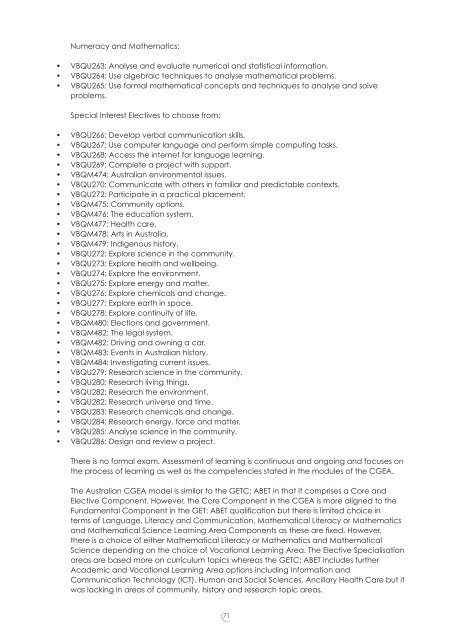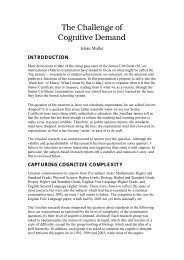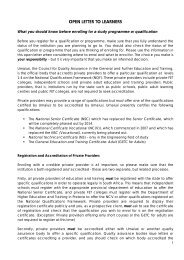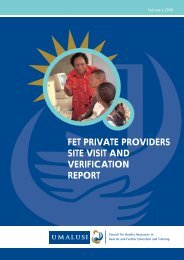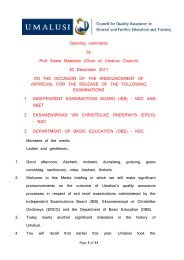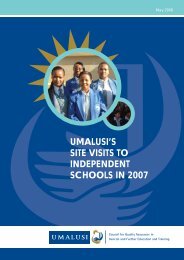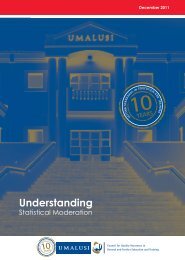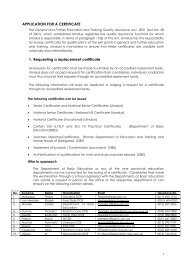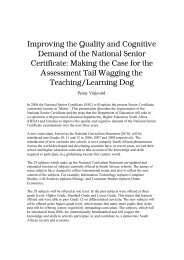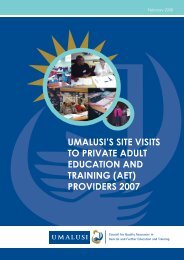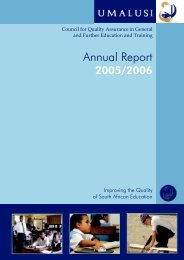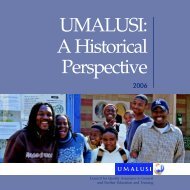Inspecting the Foundations - Umalusi
Inspecting the Foundations - Umalusi
Inspecting the Foundations - Umalusi
Create successful ePaper yourself
Turn your PDF publications into a flip-book with our unique Google optimized e-Paper software.
Numeracy and Ma<strong>the</strong>matics:• VBQU263: Analyse and evaluate numerical and statistical information.• VBQU264: Use algebraic techniques to analyse ma<strong>the</strong>matical problems.• VBQU265: Use formal ma<strong>the</strong>matical concepts and techniques to analyse and solveproblems.Special Interest Electives to choose from:• VBQU266: Develop verbal communication skills.• VBQU267: Use computer language and perform simple computing tasks.• VBQU268: Access <strong>the</strong> internet for language learning.• VBQU269: Complete a project with support.• VBQM474: Australian environmental issues.• VBQU270: Communicate with o<strong>the</strong>rs in familiar and predictable contexts.• VBQU272: Participate in a practical placement.• VBQM475: Community options.• VBQM476: The education system.• VBQM477: Health care.• VBQM478: Arts in Australia.• VBQM479: Indigenous history.• VBQU272: Explore science in <strong>the</strong> community.• VBQU273: Explore health and wellbeing.• VBQU274: Explore <strong>the</strong> environment.• VBQU275: Explore energy and matter.• VBQU276: Explore chemicals and change.• VBQU277: Explore earth in space.• VBQU278: Explore continuity of life.• VBQM480: Elections and government.• VBQM482: The legal system.• VBQM482: Driving and owning a car.• VBQM483: Events in Australian history.• VBQM484: Investigating current issues.• VBQU279: Research science in <strong>the</strong> community.• VBQU280: Research living things.• VBQU282: Research <strong>the</strong> environment.• VBQU282: Research universe and time.• VBQU283: Research chemicals and change.• VBQU284: Research energy, force and matter.• VBQU285: Analyse science in <strong>the</strong> community.• VBQU286: Design and review a project.There is no formal exam. Assessment of learning is continuous and ongoing and focuses on<strong>the</strong> process of learning as well as <strong>the</strong> competencies stated in <strong>the</strong> modules of <strong>the</strong> CGEA.The Australian CGEA model is similar to <strong>the</strong> GETC: ABET in that it comprises a Core andElective Component. However, <strong>the</strong> Core Component in <strong>the</strong> CGEA is more aligned to <strong>the</strong>Fundamental Component in <strong>the</strong> GET: ABET qualifi cation but <strong>the</strong>re is limited choice interms of Language, Literacy and Communication, Ma<strong>the</strong>matical Literacy or Ma<strong>the</strong>maticsand Ma<strong>the</strong>matical Science Learning Area Components as <strong>the</strong>se are fi xed. However,<strong>the</strong>re is a choice of ei<strong>the</strong>r Ma<strong>the</strong>matical Literacy or Ma<strong>the</strong>matics and Ma<strong>the</strong>maticalScience depending on <strong>the</strong> choice of Vocational Learning Area. The Elective Specialisationareas are based more on curriculum topics whereas <strong>the</strong> GETC: ABET includes fur<strong>the</strong>rAcademic and Vocational Learning Area options including Information andCommunication Technology (ICT), Human and Social Sciences, Ancillary Health Care but itwas lacking in areas of community, history and research topic areas.71


